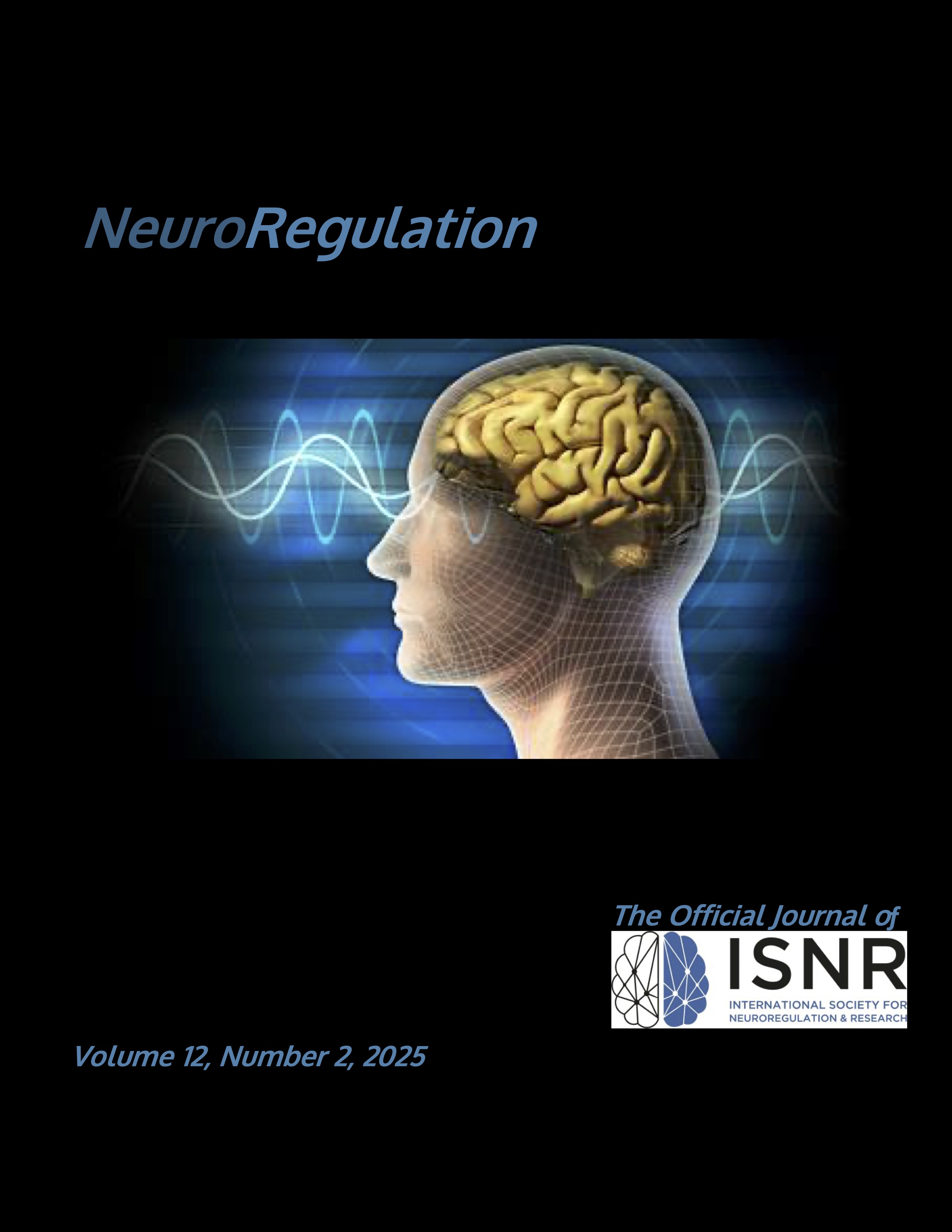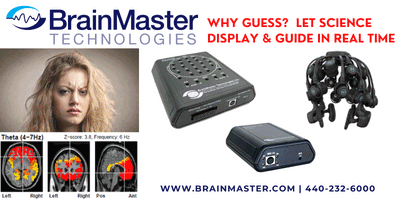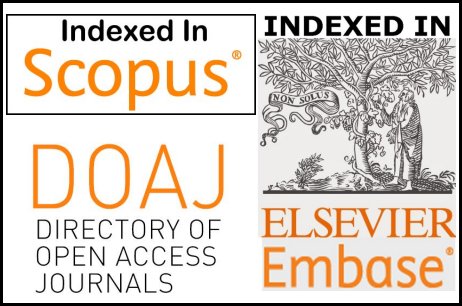Exploring Alpha and Theta Activity in Depression: A Combined Surface EEG and LORETA Study of Cortical and Subcortical Networks
DOI:
https://doi.org/10.15540/nr.12.2.89Keywords:
depression, qEEG, alpha and theta oscillations, hippocampus-amygdala network, frontotemporal areaAbstract
Introduction. Depression is a common mental health condition characterized by disrupted neural activity in cortical and subcortical networks involved in emotion and memory. While alpha and theta oscillations have been linked to depression, their specific roles in symptom domains remain unclear. This study examines these relationships using quantitative EEG (qEEG) and low-resolution electromagnetic tomography analysis (LORETA). Methods. Fifty-eight adults with depression underwent resting-state, eyes-closed qEEG. Absolute power and coherence of alpha (8–12 Hz) and theta (4–8 Hz) bands were analyzed across 19 scalp electrodes and hippocampal and amygdala regions using LORETA. Depressive symptom severity was assessed using the Beck Depression Inventory-II (BDI-II). Statistical analyses evaluated associations between EEG parameters and symptom scores. Results. Alpha coherence between the left hippocampus and amygdala negatively correlated with somatic symptoms (r = −0.298, p = .027), explaining 26% of variance in total BDI-II scores. Increased theta coherence in the right frontotemporal network was associated with reductions in affective and somatic symptoms. Conclusions. The findings identify neural oscillatory patterns within hippocampal-amygdala and frontotemporal networks as potential biomarkers for depressive symptoms, providing insights into novel therapeutic targets.
References
American Psychiatric Association. (2022). Diagnostic and statistical manual of mental disorders (5th ed., text rev.). https://doi.org/10.1176/appi.books.9780890425787
Blankenship, T. L., & Bell, M. A. (2015). Frontotemporal coherence and executive functions contribute to episodic memory during middle childhood. Developmental Neuropsychology, 40(7–8), 430–444. https://doi.org/10.1080 /87565641.2016.1153099
Bokhan, N. A., Galkin, S. A., & Vasilyeva, S. N. (2023). EEG alpha band characteristics in patients with a depressive episode within recurrent and bipolar depression. Consortium Psychiatricum, 4(3), 5–12. https://doi.org/10.17816/CP6140
Cornwell, B. R., Salvadore, G., Colon-Rosario, V., Latov, D. R., Holroyd, T., Carver, F. W., Coppola, R., Manji, H. K., Zarate, C. A., & Grillon, C. (2010). Abnormal hippocampal functioning and impaired spatial navigation in depressed individuals: Evidence from whole-head magnetoencephalography. American Journal of Psychiatry, 167(7), 836–844. https://doi.org/10.1176/appi.ajp.2009.09050614
Cui, L., Li, S., Wang, S., Wu, X., Liu, Y., Yu, W., Wang, Y., Tang, Y., Xia, M., & Li, B. (2024). Major depressive disorder: Hypothesis, mechanism, prevention and treatment. Signal Transduction and Targeted Therapy, 9(1), Article 30. https://doi.org/10.1038/s41392-024-01738-y
Damborská, A., Honzírková, E., Barteček, R., Hořínková, J., Fedorová, S., Ondruš, Š., Michel, C. M., & Rubega, M. (2020). Altered directed functional connectivity of the right amygdala in depression: High-density EEG study. Scientific Reports, 10(1), Article 4398. https://doi.org/10.1038/s41598-020-61264-z
Dev, A., Roy, N., Islam, Md. K., Biswas, C., Ahmed, H. U., Amin, Md. A., Sarker, F., Vaidyanathan, R., & Mamun, K. A. (2022). Exploration of EEG-based depression biomarkers identification techniques and their applications: A systematic review. IEEE Access, 10, 16756–16781. https://doi.org /10.1109/ACCESS.2022.3146711
Devinsky, O. (2000). Right cerebral hemisphere dominance for a sense of corporeal and emotional self. Epilepsy & Behavior, 1(1), 60–73. https://doi.org/10.1006/ebeh.2000.0025
Dong, D., Jiang, Y., Gao, Y., Ming, Q., Wang, X., & Yao, S. (2019). Atypical frontotemporal connectivity of cognitive empathy in male adolescents with conduct disorder. Frontiers in Psychology, 9, Article 2778. https://doi.org/10.3389 /fpsyg.2018.02778
Dum, M., Pickren, J., Sobell, L. C., & Sobell, M. B. (2008). Comparing the BDI-II and the PHQ-9 with outpatient substance abusers. Addictive Behaviors, 33(2), 381–387. https://doi.org/10.1016/j.addbeh.2007.09.017
Friedrich, M. J. (2017). Depression is the leading cause of disability around the world. JAMA, 317(15), Article 1517. https://doi.org/10.1001/jama.2017.3826
García-Batista, Z. E., Guerra-Peña, K., Cano-Vindel, A., Herrera-Martínez, S. X., & Medrano, L. A. (2018). Validity and reliability of the Beck Depression Inventory (BDI-II) in general and hospital population of Dominican Republic. PLoS ONE, 13(6), Article e0199750. https://doi.org/10.1371 /journal.pone.0199750
Gould, N. F., Holmes, M. K., Fantie, B. D., Luckenbaugh, D. A., Pine, D. S., Gould, T. D., Burgess, N., Manji, H. K., & Zarate, C. A. (2007). Performance on a virtual reality spatial memory navigation task in depressed patients. The American Journal of Psychiatry, 164(3), 516–519. https://doi.org/10.1176 /ajp.2007.164.3.516
LaVarco, A., Ahmad, N., Archer, Q., Pardillo, M., Nunez Castaneda, R., Minervini, A., & Keenan, J. P. (2022). Self-conscious emotions and the right fronto-temporal and right temporal parietal junction. Brain Sciences, 12(2), Article 138. https://doi.org/10.3390/brainsci12020138
Leuchter, A. F., Cook, I. A., Hunter, A. M., Cai, C., & Horvath, S. (2012). Resting-state quantitative electroencephalography reveals increased neurophysiologic connectivity in depression. PLoS ONE, 7(2), Article e32508. https://doi.org /10.1371/journal.pone.0032508
Liu, X., Zhang, H., Cui, Y., Zhao, T., Wang, B., Xie, X., Liang, S., Sha, S., Yan, Y., Zhao, X., & Zhang, L. (2024). EEG-based major depressive disorder recognition by neural oscillation and asymmetry. Frontiers in Neuroscience, 18, Article 1362111. https://doi.org/10.3389/fnins.2024.1362111
Lorenzetti, V., Allen, N. B., Fornito, A., & Yücel, M. (2009). Structural brain abnormalities in major depressive disorder: A selective review of recent MRI studies. Journal of Affective Disorders, 117(1–2), 1–17. https://doi.org/10.1016 /j.jad.2008.11.021
Lyness, J. M., Cox, C., Curry, J., Conwell, Y., King, D. A., & Caine, E. D. (1995). Older age and the underreporting of depressive symptoms. Journal of the American Geriatrics Society, 43(3), 216–221. https://doi.org/10.1111/j.1532-5415.1995.tb07325.x
Mayberg, H. (1997). Limbic-cortical dysregulation: A proposed model of depression. The Journal of Neuropsychiatry and Clinical Neurosciences, 9(3), 471–481. https://doi.org/10.1176 /jnp.9.3.471
McGaugh, J. L. (2004). The amygdala modulates the consolidation of memories of emotionally arousing experiences. Annual Review of Neuroscience, 27(1), 1–28. https://doi.org/10.1146/annurev.neuro.27.070203.144157
Platek, S. M., Keenan, J. P., Gallup, G. G., & Mohamed, F. B. (2004). Where am I? The neurological correlates of self and other. Cognitive Brain Research, 19(2), 114–122. https://doi.org/10.1016/j.cogbrainres.2003.11.014
Romeo, Z., & Spironelli, C. (2024). Theta oscillations underlie the interplay between emotional processing and empathy. Heliyon, 10(14), Article e34581. https://doi.org/10.1016 /j.heliyon.2024.e34581
Siegle, G. J., Thompson, W., Carter, C. S., Steinhauer, S. R., & Thase, M. E. (2007). Increased amygdala and decreased dorsolateral prefrontal BOLD responses in unipolar depression: Related and independent features. Biological Psychiatry, 61(2), 198–209. https://doi.org/10.1016 /j.biopsych.2006.05.048
Takahashi, E., Ohki, K., & Kim, D.-S. (2007). Diffusion tensor studies dissociated two fronto-temporal pathways in the human memory system. NeuroImage, 34(2), 827–838. https://doi.org/10.1016/j.neuroimage.2006.10.009
Tang, S., Lu, L., Zhang, L., Hu, X., Bu, X., Li, H., Hu, X., Gao, Y., Zeng, Z., Gong, Q., & Huang, X. (2018). Abnormal amygdala resting-state functional connectivity in adults and adolescents with major depressive disorder: A comparative meta-analysis. EBioMedicine, 36, 436–445. https://doi.org/10.1016 /j.ebiom.2018.09.010
Trambaiolli, L. R., & Biazoli, C. E. (2020). Resting-state global EEG connectivity predicts depression and anxiety severity. 2020 42nd Annual International Conference of the IEEE Engineering in Medicine & Biology Society (EMBC), pp. 3707–3710. Montreal, Canada. https://doi.org/10.1109 /EMBC44109.2020.9176161
Trentini, C. M., Xavier, F. M. D. F., Chachamovich, E., Rocha, N. S. D., Hirakata, V. N., & Fleck, M. P. D. A. (2005). The influence of somatic symptoms on the performance of elders in the Beck Depression Inventory (BDI). Revista Brasileira de Psiquiatria, 27(2), 119–123. https://doi.org/10.1590/S1516-44462005000200009
Tseng, H.-J., Lu, C.-F., Jeng, J.-S., Cheng, C.-M., Chu, J.-W., Chen, M.-H., Bai, Y.-M., Tsai, S.-J., Su, T.-P., & Li, C.-T. (2022). Frontal asymmetry as a core feature of major depression: A functional near-infrared spectroscopy study. Journal of Psychiatry and Neuroscience, 47(3), E186–E193. https://doi.org/10.1503/jpn.210131
Wang, Y.-P., & Gorenstein, C. (2013). Psychometric properties of the Beck Depression Inventory-II: A comprehensive review. Revista Brasileira de Psiquiatria, 35(4), 416–431. https://doi.org/10.1590/1516-4446-2012-1048
Williams, K. A., Mehta, N. S., Redei, E. E., Wang, L., & Procissi, D. (2014). Aberrant resting-state functional connectivity in a genetic rat model of depression. Psychiatry Research: Neuroimaging, 222(1–2), 111–113. https://doi.org/10.1016 /j.pscychresns.2014.02.001
Wright, N. E., Scerpella, D., & Lisdahl, K. M. (2016). Marijuana use is associated with behavioral approach and depressive symptoms in adolescents and emerging adults. PLoS ONE, 11(11), Article e0166005. https://doi.org/10.1371 /journal.pone.0166005
Yamada, M., Kimura, M., Mori, T., & Endo, S. (1995). EEG power and coherence in presenile and senile depression. Characteristic findings related to differences between anxiety type and retardation type. Journal of Nippon Medical School, 62(2), 176–185. https://doi.org/10.1272/jnms1923.62.176
Yang, J., Yin, Y., Svob, C., Long, J., He, X., Zhang, Y., Xu, Z., Li, L., Liu, J., Dong, J., Zhang, Z., Wang, Z., & Yuan, Y. (2017). Amygdala atrophy and its functional disconnection with the cortico-striatal-pallidal-thalamic circuit in major depressive disorder in females. PLoS ONE, 12(1), Article e0168239. https://doi.org/10.1371/journal.pone.0168239
Zhang, L., Hu, X., Hu, Y., Tang, M., Qiu, H., Zhu, Z., Gao, Y., Li, H., Kuang, W., & Ji, W. (2022). Structural covariance network of the hippocampus–amygdala complex in medication-naïve patients with first-episode major depressive disorder. Psychoradiology, 2(4), 190–198. https://doi.org/10.1093 /psyrad/kkac023
Zheng, J., Anderson, K. L., Leal, S. L., Shestyuk, A., Gulsen, G., Mnatsakanyan, L., Vadera, S., Hsu, F. P. K., Yassa, M. A., Knight, R. T., & Lin, J. J. (2017). Amygdala-hippocampal dynamics during salient information processing. Nature Communications, 8(1), Article 14413. https://doi.org/10.1038 /ncomms14413
Downloads
Published
Issue
Section
License
Copyright (c) 2025 Ahmad Poormohammad, Helia Pournasr, Mehrsa Soltani Miri, Arman Samimi, Kourosh Edalati

This work is licensed under a Creative Commons Attribution 4.0 International License.
Authors who publish with this journal agree to the following terms:- Authors retain copyright and grant the journal right of first publication with the work simultaneously licensed under a Creative Commons Attribution License (CC-BY) that allows others to share the work with an acknowledgement of the work's authorship and initial publication in this journal.
- Authors are able to enter into separate, additional contractual arrangements for the non-exclusive distribution of the journal's published version of the work (e.g., post it to an institutional repository or publish it in a book), with an acknowledgement of its initial publication in this journal.
- Authors are permitted and encouraged to post their work online (e.g., in institutional repositories or on their website) prior to and during the submission process, as it can lead to productive exchanges, as well as earlier and greater citation of published work (See The Effect of Open Access).











